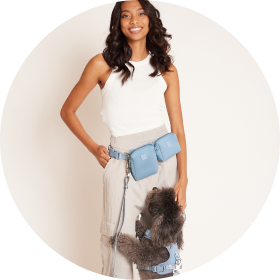- Home
- The Daily Wag!
- Senses
- Can Dogs See 3 Dimensions?
Can Dogs See 3 Dimensions?
Introduction
Can dogs see in three dimensions like humans - paws for effect ... they sure can! They can see objects around them like people and other animals - even the television remote. Humans and dogs both see light through their retinas. Colors are then sorted through cones inside the eye (yes dogs can see some colors, but not as many as humans).
Dogs have more rods inside their eyes, which enable them to have much better night vision. (A-ha - they can see in the dark! That explains how they can make their way back and forth to their water bowls in the middle of the night).
Dogs are amazing - but we need not tell you that, you already agree! A dog's field of vision is also larger than that of humans; where we can see 180 degrees, a dog can see 250 degrees. If you are standing diagonally behind your dog, he can see you without moving his eyes.
Signs That Your Dog Can See in 3 Dimensions
This is clear when your dog picks up something with their mouth, you give them a toy, or you place something in their food dish. They see the edges of the object and can more easily pick it up, eat it or play with it than if they only saw two dimensions. When you throw a ball, a dog can sense the movement of the ball and when they retrieve the ball for you, they can easily see the three-dimensional circumference of the object.
They have an innate sense of depth perception as well. They know a dog treat or a brushing chew is three dimensional because it actually goes in their mouth when they eat it. If it were two dimensions, like something a dog sees on television, they could not physically touch it.
Some of us teach our dogs to retrieve objects for us - the remote, our slippers, the newspaper, or even a nice, cold drink from the fridge. In order for our dogs to do this, the dog must see able to discern between two-dimensional and three-dimensional objects. When your dog can come into physical contact with an object, he or she knows the difference. Dogs do not try to eat pictures of food or toys in magazines - unless they have a taste for paper (Golden Labs, we're looking at you).
Ever see your dog hold an object between their paws? They either squeak it, chew it or lick it. If they have something they aren't supposed to have, however, they normally try to hide it from you, using their ability to decipher distance and space to stash their contraband.
The History of Dogs Seeing in 3 Dimensions
Now, while there is no real history on this topic, one can only assume that ever since ancient canines dwelt side-by-side with ancient cavemen, they were able to see things in three-dimensions. They were their faithful companions; they have always had our backs, even back when our backs were as hairy as theirs.
Three-dimensional sight was vital to survival when dangerous animals tried to have cavemen and their pets for lunch. Dogs have keen senses of smell and highly developed visual abilities to alert them to oncoming predators, danger, or, in today's world, traffic, firetrucks, crying children and the like.
The Science of Dogs Seeing in 3 Dimensions
Studies show that dogs not only possess a keen sense of smell, but they also have great depth perception when focusing on objects near or around them. Where we would need to shift our heads slightly to change our field of vision to see how far or close something is to us, a dog's brain does this automatically for them. It is through this automatic shift that doggos are able to comprehend and distinguish between solid, three-dimensional objects near them and a two-dimensional one like a photograph or a television screen.
Training a Dog to See in 3-D
The good news is, you don't have to train your dog to see in 3-D. Our dogs just instinctively know if an object can be held in their paws or mouth, it is three-dimensional. Most pooches even figure out that images on the TV aren't 3-D things to chase! This normally takes Fido or Fifi a few times to figure out, but they often catch on.
Naturally, dogs want to chase, play, eat, lick, or nibble all objects they see, for the most part. It is up to us as responsible pawrents to let them know what is acceptable to ingest or play with (toys, treats) and what is not (fecal matter, underwear from the hamper - no Fifi, no!).
It is important to remember while your dog is figuring out the rules of what is cool and what is not, do not hit or scream at them. They are just learning, and it is never okay to harm an animal. Plus, eradic behavior only confuses them further. A firm, "No", or a squirt of water is usually enough to get the point across.
Written by a Smooth Coated Collie lover Mary Alane Whalen
Veterinary reviewed by:
Published: 02/26/2018, edited: 04/06/2020
More articles by Mary Alane Whalen
